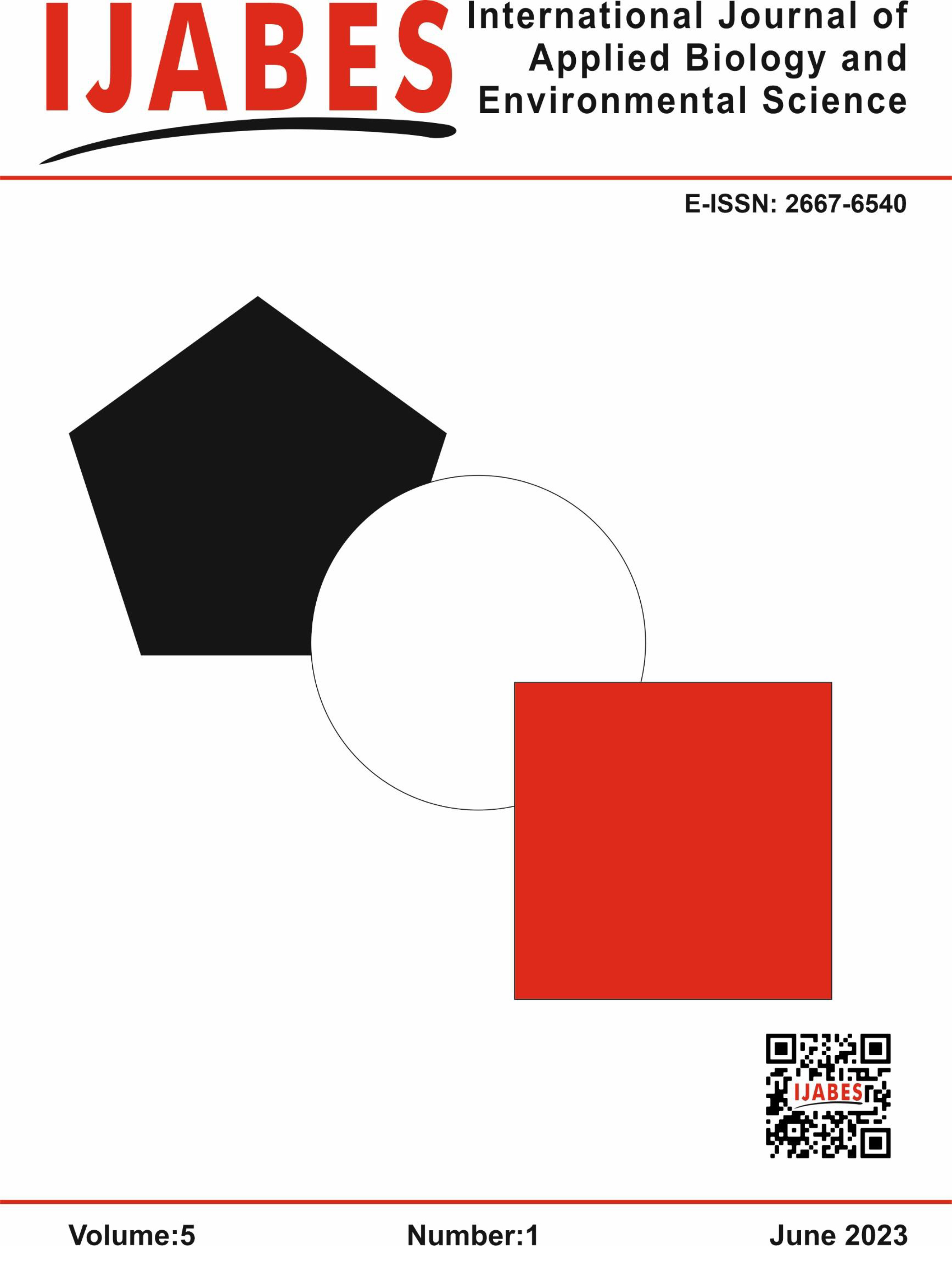








Yayımcı adresi: Hadımköy TOKİ Mevlana Cd. B1/2 D:2
Hadımköy / Arnavutköy / İstanbul

This work Licensed under the Creative Commons Attribution 4.0 International License.
Volume: 5 Issue: 2 - 2023
| 1. | Cover Page I |
| 2. | Contents Pages II - III |
| ORIGINAL RESEARCH | |
| 3. | Characterization of Seed Lipid Composition in Some Crops Grown in Eskişehir Province in Türkiye Murat Olgun, Arzu Köse, Savaş Belen, Yaşar karaduman, Zekiye Budak Basçıftçı, Nazife Gözde Ayter Arpacıoğlu, Metin Turan doi: 10.5505/ijabes.2023.00710 Pages 42 - 52 In this study, wheat, barley and oat lipids were examined comparatively with safflower oil and their quality values were revealed. Bread Wheat Genotypes; Bezostaja, Yunus, Altay, Müfitbey and Nacibey; Barley Genotypes; 4193, İnce, 5252, Özdemir and Ünver; Oat Genotypes; Checota, Seydişehir, Yeniçeri, Kırıklar and Kahraman; Safflower Genotypes; Yenice, Dinçer, Balcı, Linas and Olas were used. Seed lipid composition in bread wheat, barley, oat and safflower genotypes were determined. In bread wheat; the numbers of genotypes with the highest values in terms of components were similar. In barley; İnce and Ünver genotypes had the highest values in more components than other barley genotypes. In oats; Checota and Kırıklar genotypes, as the genotypes with the highest values, have a clear difference compared to other oat genotypes. In safflower; Except for Yenice and Linas; Dinçer, Balcı and Olas genotypes had the highest values in more components. In bread wheat, barley, oats and safflower; for all genotypes, asparagine, glycine, APX, vitamin B2, vitamin B6 were determined to be more effective than other components in the production of quality seed lipid. Barley and oat genotypes showed superior performance compared to wheat and safflower genotypes. This shows that barley and oats are of high quality and rich in chemical content. Özdemir and Ünver genotypes were determined as superior performing and stable genotypes. |
| 4. | THE EFFECT OF DIFFERENT MIXTURE RATIOS OF MAIZE (Zea mays L.) AND SOYBEAN (Glycine max L.) ON SOME SILAGE QUALITY CHARACTERISTICS Gülcan Demiroğlu Topçu, Melike Kızılşimşek, Fatma AKBAY doi: 10.5505/ijabes.2023.14633 Pages 53 - 63 This research was conducted in order to determine the effects on silage quality of different mixtures of maize (Zea mays L.) (M) and soybeans (S) (Glycine max L.) (100%M, 80%M+20%S, 60%M+40%S, 40%M+60%S, 20%M+80%S and %100S) in the experimental fields of Ege University Agriculture Faculty Department of Field Crops, second crop season in 2022-2023. The study examined the physical properties of silage and the quality of the silage. As a result of the research color, structure, odor and DLG score of silage were between 1-2, 8,5-13,5, 3-4, 12,5-19,5 respectively. In addition to, DM content, pH value, CP ratio, NDF, ADF, DMI, DMM, RFV value were between 28,51-30,73%, 4.06-5,10, 7,12-15,23%, 40,69-45,02%, 27,93-32,40%, 2,66-2,95%, 63,66-67,14%, and 135,89-153,58 respectively. According to the results obtained, it was determined that by adding soybean to maize silage, the crude protein content of maize increased and the silage fermentation of soybean improved. When all the features were examined, it was concluded that 20% or 40% soybeans should be added to maize silages |
| 5. | Determination of Yield and Some Quality Characteristics of Different Bread Wheat (Triticum aestivum L.) Genotypes Grown in Central Anatolian Region Yunus Küçükkaya, ZEKIYE BUDAK BASÇIFTÇI doi: 10.5505/ijabes.2023.66375 Pages 64 - 69 This study was conducted to determine the yield and quality characteristics of some bread wheat (Triticum aestivum L.) genotypes in the NBC Agriculture and R&D trial area of Yıldızören Village, Çifteler District, Eskişehir province, during the 2021-2022 growing season. Grain yield (kg/da), thousand grain weight (kg), protein ratio (%), test weight (kg), gluten ratio (%), hardness value, sedimentation value (ml) were examined as grain yield and quality characteristics. In the study, grain yield was 361-562 kg/da, thousand grain weight was 29.31-40.47 g, protein rate was 10.59-12.83%, test weight was 74.70-81.50 kg/hl, gluten was 20, It was determined that it varied between 87-27.35, hardness value 27.37-66.49 and sedimentation value 25.81-39.35 ml. Genotypes differed at the 1% level in terms of the examined traits. As a result, since selection should be made by taking into account the effect of ecological conditions on the yield and quality characteristics of genotypes, Mesutozen and Çavuş genotypes, which have a reasonable level of yield as well as quality characteristics, are recommended. |
| 6. | CHANGES ON ACREAGE, PRODUCTION, AND SEED YIELD OAT (Avena sativa L.) IN TÜRKIYE Murat Olgun doi: 10.5505/ijabes.2023.85570 Pages 70 - 78 In this study, the changes (increases/decreases) on acreage, production and seed yield in oat in Turkey after the 1930s was examined by using statistical analysis. In the analysis of oat agriculture made over many years and in twenty-year periods, it was revealed that oat agriculture in Turkey should be examined in two distinct periods. These two distinct periods can be examined as before the 1970s and after the 1970s. While oat production increased before the 1970s, it entered a decline after the 1970s. On the other hand, grain yield has consistently increased. Until the 1970s, which was the first period, production increase was possible with the expansion in acreages. Already in this period, acreages have reached their marginal limits. After this period, production decreased along with a contraction in cultivated areas. However, this decrease rate was less than in the first period. Although not at the desired level, the use of high-yielding registered varieties and the increasing use of modern cultivation techniques have led to a significant increase in grain yield per unit area. This situation also reduced the rate of decrease in efficiency. Oat production in Turkey is not at the desired level. Increasing the production amount of oats, which is increasingly important in terms of animal feed needs and human nutrition in Turkey, is only possible by increasing the use of high-yielding varieties. Additionally, oat breeding programs need to be expanded and activated. |